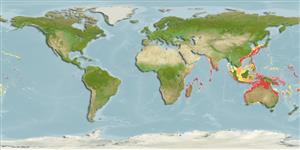Malacostraca |
Decapoda |
Scyllaridae
Environment: milieu / climate zone / depth range / distribution range
Ecology
Benthic; depth range 10 - 135 m (Ref. 4). Tropical; 37°N - 35°S, 29°E - 150°W (Ref. 4)
Indo-Pacific.
Length at first maturity / Size / Weight / Age
Maturity: Lm ? range ? - ? cm Max length : 17.0 cm CL male/unsexed; (Ref. 122423); common length : 50.0 cm TL male/unsexed; (Ref. 4)
Minimum depth from Ref. 4. It has lengths of 50 cm, total body length; 4.5 and 17 cm, carapace length (Ref. 4). Fisheries: commercial (Ref. 91361). Known from depths between 10 and 135 m; probably in rocky bottom (Ref. 4).
Life cycle and mating behavior
Maturity | Reproduction | Spawning | Eggs | Fecundity | Larvae
Members of the order Decapoda are mostly gonochoric. Mating behavior: Precopulatory courtship ritual is common (through olfactory and tactile cues); usually indirect sperm transfer.
Holthuis, L.B. 1991 FAO Species Catalogue. Vol. 13. Marine lobsters of the world. An annotated and illustrated catalogue of species of interest to fisheries known to date. FAO Fish. Synop. 125(13):292p. Rome: FAO. (Ref. 4)
IUCN Red List Status
(Ref. 130435: Version 2025-1)
CITES status (Ref. 108899)
Not Evaluated
Not Evaluated
Threat to humans
Human uses
Fisheries: commercial
| FishSource |
Tools
More information
Trophic EcologyFood items (preys)
Diet composition
Food consumption
Predators
Population dynamicsGrowthMax. ages / sizesLength-weight rel.Length-length rel.Length-frequenciesMass conversionAbundance Life cycleReproductionMaturityFecunditySpawningEggsEgg developmentLarvae PhysiologyOxygen consumption
Human RelatedStamps, coins, misc.
Internet sources
Estimates based on models
Preferred temperature
(Ref.
115969): 17.4 - 28.3, mean 26.6 (based on 632 cells).
Fishing Vulnerability
Low vulnerability (10 of 100).
